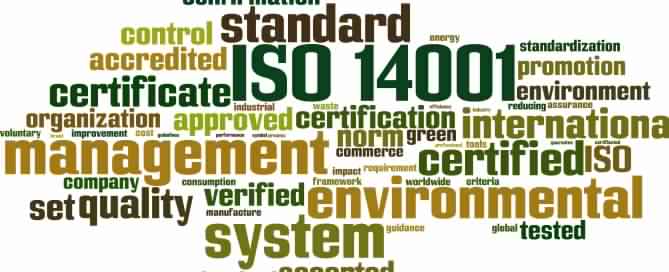ISO 14001:2015 Environmental Management System.
ISO 14001:2015 is a series of environmental management standards developed and published by the International Organization for Standardization (ISO) for organizations. The ISO 14000:2015 standards provide a guideline or framework for organizations that need to systematize and improve their environmental management efforts.
The ISO 14001:2015 standard is the most important standard within the ISO 14000 series. ISO 14001:2015 specifies the requirements of an environmental management system (EMS) for small to large organizations. An EMS is a systemic approach to handling environmental issues within an organization. The ISO 14001 standard is based on the Plan-Check-Do-Review-Improve cycle.
The Plan cycle deals with the beginning stages of an organization becoming ISO 14001:2015 compliant. The Check cycle deals with checking and correcting errors. The Do cycle is the implementation and operation of the ISO 14001:2015 standard within an organization. The Review cycle is a review of the entire process by the organization’s top management. And the Improve cycle is a cycle that never ends as an organization continually finds ways to improve their EMS.
What is an environmental management system?
An environmental management system helps organizations identify, manage, monitor and control their environmental issues in an “aggregate” manner. This means that ISO 14001:2015 can be integrated easily into any existing ISO management system. ISO 14001:2015 is suitable for organizations of all types and sizes, be they private, not-for-profit or governmental. It requires that an organization considers all environmental issues relevant to its operations, such as air pollution, water and sewage issues, waste management, soil contamination, climate change mitigation and adaptation, and resource use and efficiency. Like all ISO management system standards, ISO 14001:2015 includes the need for continual improvement of an organization’s systems and approach to environmental concerns. The standard has recently been revised, with key improvements such as the increased prominence of environmental management within the organization’s strategic planning processes, greater input from leadership and a stronger commitment to proactive initiatives that boost environmental performance.
What benefits will it bring to my business or organization?
There are many reasons why an organization should take a strategic approach to improving its environmental performance. Users of the standard have reported that ISO 14001:2015 helps:
- Demonstrate compliance with current and future statutory and regulatory requirements Increase leadership involvement and engagement of employees
- Improve company reputation and the confidence of stakeholders through strategic communication
- Achieve strategic business aims by incorporating environmental issues into business management
- Provide a competitive and financial advantage through improved efficiencies and reduced costs
- Encourage better environmental performance of suppliers by integrating them into the organization’s business systems
- Increased demand for their services and products through a marketing advantage;
- Lowering business costs through reducing resource consumption and waste production;
- Improving their environmental performance, reducing their environmental impact and controlling environmental risk;
- Achieving their environmental commitments and environmental policy requirements;
- Meeting their environmental legal requirements;
- Committing to social responsibilities;
- Promoting a positive image with stakeholders, customers and employees; and
- Retaining environmental knowledge and ensuring information is effectively communicated.
ISO 14001:2015 Revisions
The 2015 revision of ISO 14001:2015 introduces a number of changes from previous versions. All ISO standards are reviewed and revised regularly to make sure they remain relevant to the marketplace. ISO 14001:2015 will respond to the latest trends, including the increasing recognition by companies of the need to factor in both external and internal elements that influence their environmental impact, such as climate volatility and the competitive context in which they work. The changes also ensure that the standard is compatible with other management system standards.
10 major areas of impact of the 2015 revision:
- Expansion in EMS coverage and scope
- Required interactions with external parties
- New requirements for leadership engagement
- Expanded legal compliance requirements
- Need for risk-based planning and controls
- New documentation requirements
- Expanded operational control requirements
- Changes in competence and awareness requirements
- Impacts on the internal audit program
- Increased certification costs
The ISO 14001:2015 requirements are broadly separated into 10 sections (called ISO 14001 clauses), with clauses one through three describing the standard and clauses four through 10 containing the requirements for an EMS: Context of the organization (clause 4), Leadership (clause 5), Planning (clause 6), Support (clause 7), Operation (clause 8), Performance evaluation (Clause 9) and Improvement (clause 10). Clauses 1 through 3 include no requirements, but instead deal with the scope of the standard, normative references to understand the standard better, and terms and definitions used in the standard.
The element of ISO 14001:2015
Within the standard there are numerous elements of ISO 14001:2015 that are required to be met by organizations seeking formal recognition for their EMS. General requirements include:
- Development of an Environmental Policy that reflects an organization’s commitments;
- The appointment of a person(s) responsible for the EMS’s coordination;
- Identification of how the organization interacts with the environment;
- Identification of actual and potential environmental impacts;
- Identification of Environmental compliance requirements;
- Establishment of environmental objectives, targets and programs;
- Monitoring and measurement of the progress to achieve its objectives;
- Reviewing the system and environmental performance; and
- Continuous improvement of the organization’s environmental performance.
Contact Us Today or send an Enquiry for your ISO 14001:2015 requirements.

